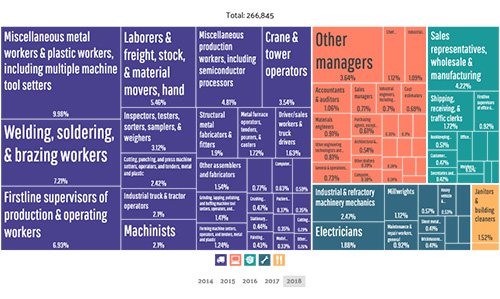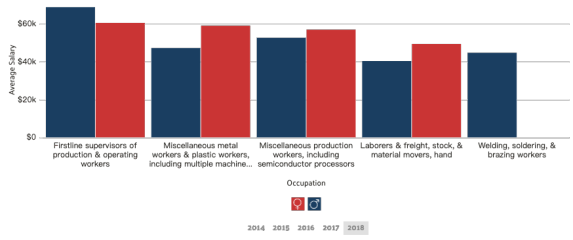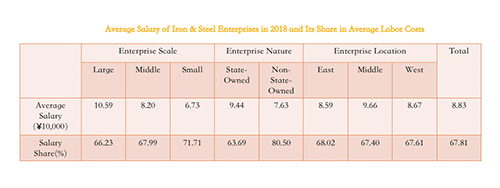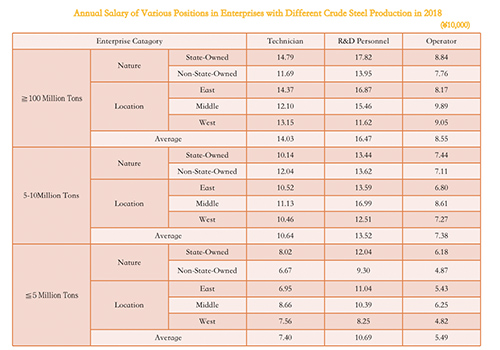

2020/06/05
3219
Based on the American BLS (Bureau of Labor Statistics) estimates, the number of people employed by iron & steel mills and steel product manufacturing groups in 2018 was 378,000. iron & steel mills and steel product manufacturing industry proved to be the 78th one with the highest income among the 269 industry groups in the United States, followed by the alcoholic beverage industry and aluminum production and processing.
1.Highest Salary Goes to Chief Executives & Legislators
ACS (American Chemical Society) estimates that the number of employees in steel mills and steel product manufacturing industry groups has been growing at a rate of 4.09%, from 269,000 individuals in 2017 to 280,000 in 2018.
Full-time employees of steel mills and steel product manufacturing industry enterprises work an average of 45.7 hours per week, with an average annual salary of $64,591. In comparison, part-time employees work 20.7 hours and the average annual salary is $18,189 through the average age of 44.4. And the highest average salary in iron & steel mills & steel product manufacturing goes to chief executives & legislators with an average amount of $176,507 in 2018.
2. Occupations by Share
As the data shows, the top three occupations in the iron & steel mills & steel product manufacturing industry are miscellaneous metal workers & plastic workers, including multiple machine tool setters, welding, soldering, & brazing workers, firstline supervisors of production & operating workers, laborers & freight, stock, & material movers, hand, and miscellaneous production workers, including semiconductor processors. Compared to other industries, iron & steel mills & steel product manufacturing unusually employs an high number of metal furnace operators, tenders, pourers, & casters, structural metal fabricators & fitters, as well as crane & tower operators.
According to ACS estimates, the chart below shows the proportion of employment by iron & steel mills & steel product manufacturing. Miscellaneous metal workers & plastic workers, including multiple machine tool setters represent the largest share of positions held in iron & steel mills & steel product manufacturing at 9.5%, followed by welding, soldering, & brazing workers with 6.86% and firstline supervisors of production & operating workers with 6.59%.

3. More Even Salary Distribution
American iron & steel mills and steel product manufacturing has a wage GINI of 0.352, lower than the U.S. average of 0.479. That is, wages are distributed more evenly in comparison to the stateside average level in iron & steel mills & steel product manufacturing.
4. Male Employees Earn 1.26 Times More than Female Ones
Male employees, with average respective salaries of $65,048, tend to earn more than female workers who earn $51,449 averagely. Also in a tend to earn more than other races and ethnicities in this industry. It is proved that 87.5% of workers in the iron & steel mills & steel product manufacturing industry are male, making them the more common gender in the workforce, which shows a great gender breakdown of the iron & steel mills & steel product manufacturing industry group. The data also shows that male workers in the iron & steel mills & steel product manufacturing industry make 1.26 times more than their female counterparts.

5. Average Salary of China's Iron & Steel Employees Reaches $12392
It’s shown that on average, Asian employees in the industry earn 1.21 times more than other races and ethnicities. For instance, in 2018, the average salary of on-duty workers in China's iron and steel enterprises goes up to about $12392, an increase of 17.40% compared with nearly $10,554 in 2017. With an increase of more than 10% for three consecutive years, the wage level has been lifted up significantly.
In 2018, divided by the scale, nature, and region of different groups, iron & steel enterprises offering higher average wages have relatively higher labor costs per capita, with a relatively low ratio of average wages to labor costs though.

Among large enterprises with crude steel production of 10 million tons or more in 2018, the annual salaries of technicians, R&D personnel, and operators in state-owned enterprises are higher than those in non-state-owned enterprises. In terms of the eastern, central and western regions, the annual salary of technical and R&D personnel in eastern enterprises is the highest, while the salary of operating personnel in central enterprises reaches the top.
Compared with the enterprises with crude steel output of 5 million to 10 million tons and less than 5 million tons in 2018, the average annual salary of each position in large enterprises is correspondingly the highest. Among state-owned eastern enterprises of different sizes, large-scale groups have the highest annual salary per capita for each position. As for non-state-owned enterprises of different sizes in central and western regions, the average annual salary of each occupation varies in different levels.

(Data from DATA USA)